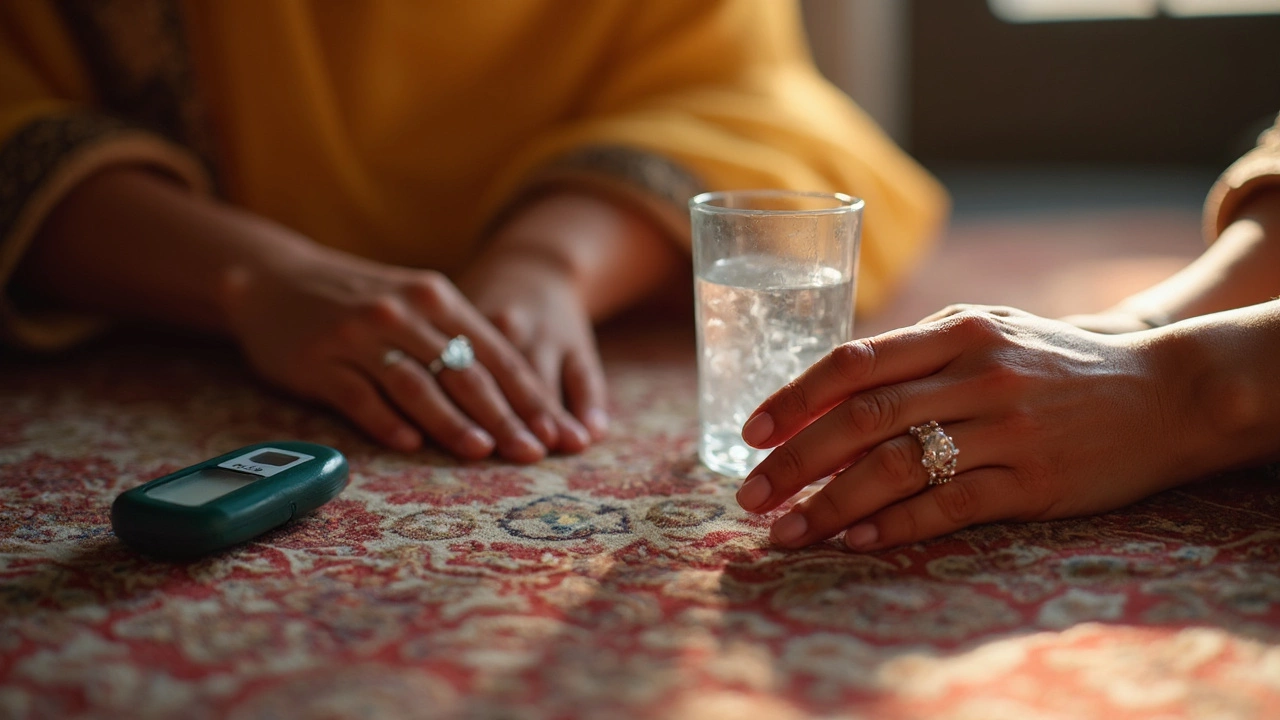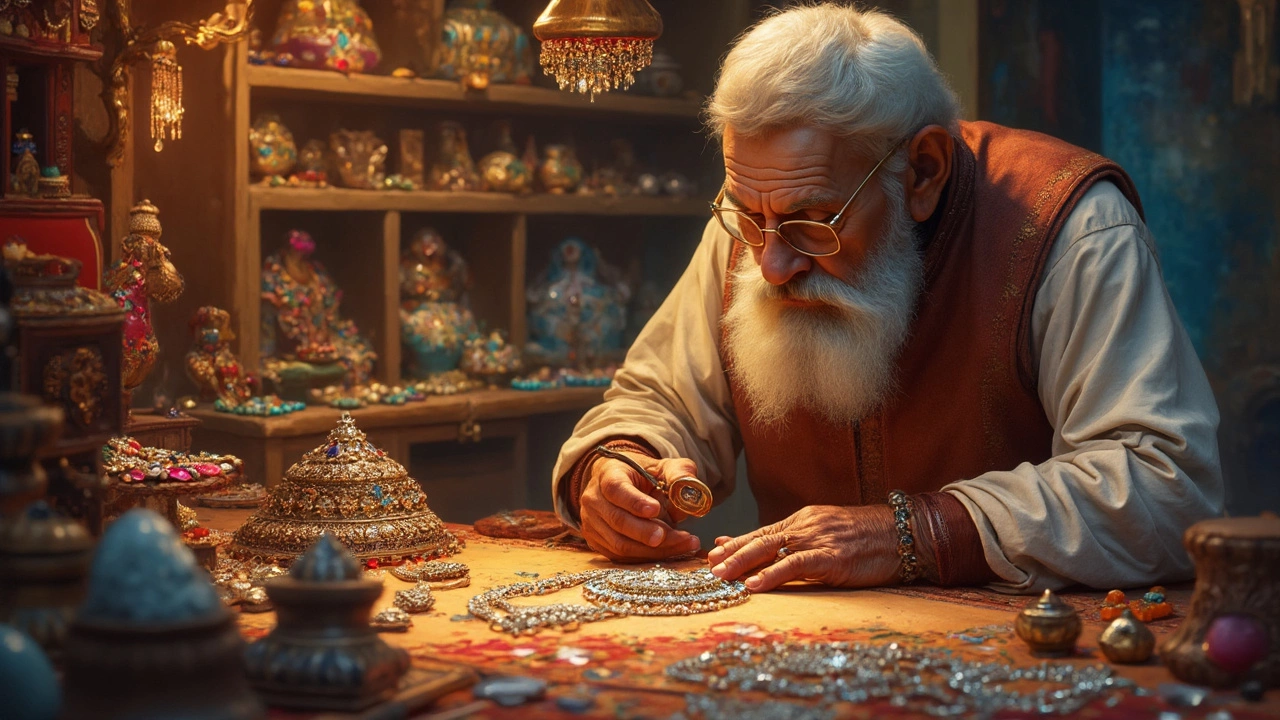Ever been handed down a piece of sparkling joy and wondered, 'Is this diamond really the real deal?' You're not alone! Figuring out whether a diamond is genuine doesn't always require a magnifying glass and a jeweler's loupe. Let’s dive into some practical pointers that can save you a headache—or a few bucks—whether you're perusing your grandma’s jewelry box or hunting at an antique fair.
Start with a basic trick: the fog test. Just breathe on the diamond like you’re cleaning your glasses. If it stays fogged for a few seconds, it might be a fake. Real diamonds disperse heat quickly, so the fog should vanish almost instantly. Handy, right?
There’s also the trusty water test. Drop your suspected diamond into a glass of water. Diamonds have high density, so a real one will sink like a stone (pun intended). A fake might just float or sink much slower.
- Spotting the Fake from the Genuine
- Simple DIY Tests at Home
- Professional Methods for Verification
- The Role of Inscriptions and Certifications
- Why Knowing This Matters for Antique Jewelry
Spotting the Fake from the Genuine
When it comes to identifying whether a diamond is real, having a keen eye and knowing what to look for can save you from disappointment. There's more to it than just checking if it sparkles; real diamonds have distinct characteristics.
Check the Setting and Mount
A quick initial test involves examining the setting and mount. High-value diamonds are typically set in materials like white gold, platinum, or real gold. If your stone is set in a cheap metal, be cautious. Look for markings like “10K” or “18K” for gold, “PT” or “Plat” for platinum, indicating the metal quality is right for a genuine piece.
Examine Under a Loupe
Experts often use a loupe, but you don't have to be a jeweler to start spotting clues. Real diamonds generally have tiny imperfections, known as inclusions, and slight color variations. A flawless stone can be suspicious unless it's certified—an indication of simulants like cubic zirconia.
The Light Test
Ever heard of the light test? Real diamonds sparkle with a grey and white brilliance, rather than a rainbow shine seen with fakes. Hold your diamond under a lamp, and observe the type of reflection it casts. Too much color is a red flag.
Heat and Resistance
Lastly, consider heat resistance. A real diamond withstands fire. For a daring test (best left to professionals), a blowtorch or lighter should cause no harm, unlike imitations that can crack under stress.
Trust your senses and these tests next time you're faced with a mystery gem; they’re key in unraveling the authenticity of any piece of antique jewelry.
Simple DIY Tests at Home
So you’ve got a pretty stone on your hands, and you’re itching to find out if it’s a real diamond. While professional verification is tops, there are some easy tests you can do right at home.
Fog Test
This one's a breeze! Breathe hot air onto your diamond, just like you’re trying to fog up glasses. Real diamonds dissipate heat quickly, so the fog will clear up almost instantly. If it lingers for several seconds, you might have a faux stone.
Water Test
Fill up a regular glass with water. Gently drop your stone into the glass. A genuine diamond will sink straight to the bottom due to its high density. If it floats or hovers above the bottom, it’s probably not the real deal.
Scratch Test
Now, don't let the name intimidate—this isn't about destroying your lovely stone! Diamonds are one of the hardest materials out there. Try scratching a mirror or glass surface softly with your stone. A real diamond should mark the glass. But be careful! This test can damage both your potential diamond and the scratched surface if not done carefully.
Refractivity Test
Diamonds bend light differently than fakes. Flip your loose diamond over, and place it on a newspaper. If you can read the letters through the stone, or if it looks like a complete circle, it’s probably not a genuine diamond. Real diamonds scatter light in various directions due to high refractivity.
While these tests aren’t conclusive, they’re great initial checks. Always consider consulting a jeweler for the best outcome. Antique jewelry is precious, and knowing your stone's worth adds to the charm and story of the piece!

Professional Methods for Verification
When your at-home tests leave you scratching your head, it's time to call in the pros. Jewelers have some nifty tricks up their sleeves to help determine if a diamond is real or if your sparkler is just a well-crafted replica.
Use of a Loupe
A jeweler's magnifying glass, known as a loupe, is a basic tool in the diamond-testing toolkit. Pros use it to check for natural imperfections, or 'inclusions.' A genuine diamond will usually have tiny flaws, while many fakes look too perfect. If your stone looks flawless, it's either super rare—lucky you—or possibly not a real diamond.
Conducting a Thermal Conductivity Test
This is one of the most foolproof tests. Jewelers use specialized devices like the DiamondNite tester. Real diamonds disperse heat quicker than wannabe stones, and this test can distinguish between a myriad of stones and the real McCoy. It’s almost like magic!
Checking with a Gemologist
If you're seriously curious about the authenticity of a stone—especially in precious antique pieces—you might consider visiting a certified gemologist. Their advanced equipment can detect authenticity, value, and even origin, giving you the full scoop on your antique jewelry.
Why Professional Verification Matters
Professional verification isn't just for peace of mind—it's pretty crucial when it comes to insurance, resale, and valuating family heirlooms. Knowing your antique jewelry is legit can add to its sentimental and financial value.
| Test | Accuracy |
|---|---|
| Loupe Examination | 80% |
| Thermal Conductivity Test | 95% |
| Gemologist Appraisal | 99% |
Each of these methods adds a layer of certainty to your authentication process and ensures that you're holding onto a piece truly worth its weight in gold—or should we say diamond!
The Role of Inscriptions and Certifications
Ever wondered why some diamonds come with tiny letters or numbers? Those are inscriptions, and they’re kind of like the diamond’s passport. These inscriptions are laser-engraved on the girdle (that’s the edge) of the real diamond and can include details about the stone's certification or the diamond's unique ID number.
Why Inscriptions Matter
Check this out: a genuine diamond may come with inscriptions that match its certification. This adds an extra layer of trust. If you're dealing with antique jewelry, these inscriptions can be invaluable. They help confirm the diamond's authenticity and can even provide a clue about the diamond's heritage. Cool, right?
Let’s not forget certifications. Certification is like the gold standard for diamonds. It’s a report from a gemological lab confirming the diamond's characteristics. Reputable labs like the Gemological Institute of America (GIA) or the American Gem Society (AGS) give the diamond a full workup.
Checking Certifications
- Verify with the Lab: Cross-check the certification number engraved on the diamond with the lab's database to ensure its legitimacy. Most labs have online tools for this.
- Double-check the Details: Certifications include diamond details like the carat, color, and clarity. Ensure the physical characteristics align with what's on paper.
For those of us excited by stats, did you know that over 90% of diamonds in the market come with some form of certification? Kind of like having a driver's license for your gem!
Why This Matters for Antique Jewelry
When it comes to antique jewelry, inscriptions and certifications become your best friends. They not only assure you of authenticity but help establish the piece's age and value. That’s why, before handing over your cash at an estate sale, it pays to double-check these details.

Why Knowing This Matters for Antique Jewelry
Diving into the world of antique jewelry is an adventure! But it's not without its pitfalls. Knowing how to identify a real diamond ensures you're getting not just beauty but genuine value. Antique pieces, after all, come with stories and a hefty price tag at times.
One key reason is investment. Real diamonds hold—and often increase—their value over time, while fakes, well, don't. They may look pretty today but lose their charm tomorrow. Given that some antique diamonds have been around for over a century, many are considered heirlooms. You'd want to ensure you're preserving and passing on something truly valuable, right?
Heritage and Authenticity
Antique jewelry carries the weight of history. Imagine wearing a piece that's witnessed events long before you were born. This connection to the past is exhilarating, as long as it’s authentic. Knowing your diamond is genuine heightens this historical connection and ensures you're cherishing a piece that is, indeed, a witness to time.
Avoiding Costly Mistakes
Let’s not forget the money factor—it’s huge! Spending big bucks on what you believe to be an original, only to find out it’s a fake, can be heartbreaking. However, understanding these diamond test techniques can be the armor you need against deceptive practices.
Beyond the Surface
Lastly, let’s talk craftsmanship. Authentic antique pieces often boast exceptional craftsmanship that deserves recognition. Identifying real diamonds isn’t just about the stone itself but appreciating the artistry involved. Many vintage pieces were hand-crafted, a far cry from today’s mass production, adding layers of value beyond the carat.
All in all, whether for historical connection, investment, or the pure joy of knowing you have the real thing, learning these skills is a game-changer in the antique jewelry game. Plus, who doesn't like to show off a little diamond know-how at auctions or family gatherings?



